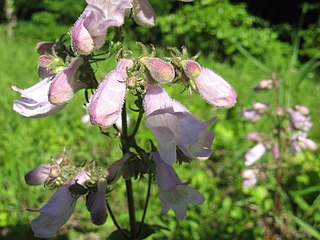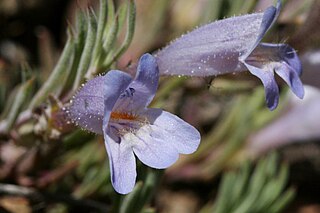
Penstemon barbatus, known by the common names golden-beard penstemon, and beardlip penstemon, is a flowering plant native to the western United States.

Penstemon strictus, the Rocky Mountain penstemon, is a penstemon with showy blue flowers.

Cordylanthus capitatus, the Yakima bird's-beak or clustered bird's-beak, is an uncommon plant of the Western U.S.

Penstemon digitalis is a species of flowering plant in the plantain family, Plantaginaceae. The flowers are white and are borne in summer. It is native to eastern Canada and the eastern and southeastern United States. Penstemon digitalis is the most widespread species of Penstemon east of the Mississippi River.

Penstemon grandiflorus, known by the common names shell-leaved penstemon, shell-leaf beardtongue, or large-flowered penstemon, is a tall and showy plant in the Penstemon genus from the plains of North America. Due to its large flowers it has found a place in gardens, particularly ones aimed at low water usage like xeriscape gardens.
Francis Whittier Pennell was an American botanist best known for his studies of the Scrophulariaceae. Employed by the New York Botanical Garden and then by the Academy of Natural Sciences of Philadelphia, he carried out botanical research in both North America and South America.

Ceanothus herbaceus, also known as Jersey tea, is a species of shrub in the family Rhamnaceae and is similar to Ceanothus americanus and Ceanothus sanguineus. It is a perennial shrub which is native to North America.

Castilleja integra, with the common names orange paintbrush, Southwestern paintbrush, and wholeleaf paintbrush, is a partially parasitic herbaceous perennial plant native to the Southwestern United States and Northern Mexico. The species produces a relatively large amount of nectar and is attractive to hummingbirds. It is better suited to cultivation than most other species in the paintbrush genus (Castilleja) and is therefor used in xeriscape gardens and naturalistic meadows, even outside its native range.

Mecardonia (axilflower) is a genus of herbaceous plants in the family Plantaginaceae. 31 species have been described, of which 12 are accepted. Its distribution is predominantly in South America, and South East United States, including Florida and Alabama but may be found as far north as Virginia. (see map) Five species are found in Argentina and three in the US.

Penstemon calycosus, commonly called long-sepal beardtongue, is a species of plant in the plantain family (Plantaginaceae). It is native to eastern North America, where it native to the Upper South and Midwestern United States. It expanded its range into the northeast United States in the early 20th century. Its natural habitat is in open woodlands, prairies, and bluffs, often over limestone.

Penstemon tenuis is a species of flowering plant in the plantain family known by the common name sharpsepal beardtongue. It is endemic to Texas, Louisiana, Mississippi, and Arkansas in the United States where it is found in open, damp areas in alluvial soil. It typically flowers from early April into early June.

Penstemon australis is a perennial plant native to the southeastern United States, with the common name Eustis Lake penstemon.

Penstemon whippleanus, commonly known as dusky penstemon, dusky beardtongue, Whipple's penstemon, or Whipple's beardtongue, is a summer blooming perennial flower in the large Penstemon genus. It is a widespread plant within the hemiboreal forests of the Rocky Mountains in North America. It is noted for the large deep purple-red flowers and a preference for high mountain elevations.

Penstemon virens, commonly known as blue mist penstemon, Front Range penstemon, or Green beardtongue, is a common Penstemon in the Front Range foothills in Colorado and Wyoming. The dainty flowers are an ornament to many rocky or sandy area within its range. It is confusingly similar to Penstemon humilis and Penstemon albertinus though the ranges of these plants do not overlap in the wild. The origin of calling it the "blue mist penstemon" is not precisely known, but is thought to relate to the large number of blue flowers the plant can produce reminding observers of a blue mist.

Penstemon albidus, commonly known as white penstemon, white-flower beardtongue, or Red-Line Beardtongue is a very widespread perennial flower of the mixed-grass and shortgrass prairies. Its natural distribution is from Manitoba and Alberta in Canada to Texas and New Mexico in the United States. The bright white flowers for which they are named are quite attractive to both bees and hummingbird moths.

Penstemon secundiflorus, commonly known as sidebells penstemon, or orchid beardtoungue is a species of Penstemon that grows in dry forests, high plains, and scrub lands from Wyoming to Mexico. It is a herbaceous perennial plant that typically grows to a height of 20 to 50 cm and has narrow, lance-shaped leaves that are grayish-green in color. The flowers of the sidebells penstemon are tubular in shape and are arranged in a one-sided spike, with the blooms all facing the same direction, and for this reason was named "secundiflorus", which means "one-sided flowers". The flowers are most often delicate shades of orchid or lavender. It is sometimes used in xeriscaping, rock gardens, and wildflower meadows, and is well-suited to dry, sunny locations with well-draining soil.

Penstemon ambiguus, commonly known as the bush penstemon, pink plains penstemon, or gilia beardtongue is a species of Penstemon that grows in the shortgrass prairies and deserts of the western United States and northern Mexico. This bush-like penstemon grows in sandy, loose, and creosote soils and is particularly known for the spectacular flowering show it produces, sometime seasons turning whole hillsides bright pink–white.

Penstemon auriberbis, commonly known as the Colorado penstemon or Colorado beardtongue, is a species of Penstemon that grows in the shortgrass prairies of southern Colorado and in a few places in northern New Mexico. Although specimens were collected on the 1820 expedition by Stephen H. Long through the area, they were not scientifically described as a separate species until 1920.

Penstemon caespitosus, commonly known as mat penstemon, is a summer blooming perennial flower in the large Penstemon genus. It is a widespread plant from near timberline to the foothills in the Southern Rocky Mountains and Colorado Plateau in North America. It is noted for its ground hugging growth habit and as a plant used in xeriscape and rock gardening.

Penstemon albifluvis, the White River penstemon, is a disputed species or variety of Penstemon that grows in a small area in eastern Utah and western Colorado. It grows mainly on broken shale and rock formations in desert habitats. White River penstemon is very rare.




















